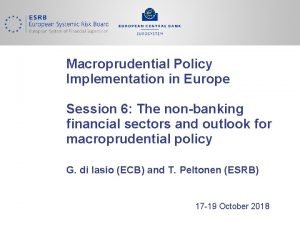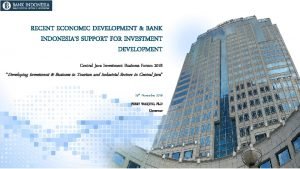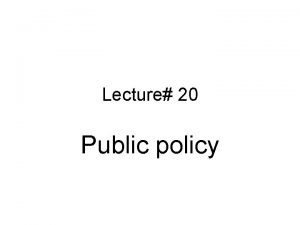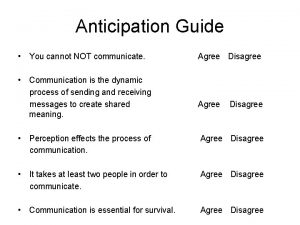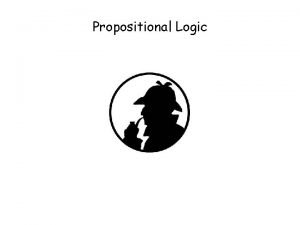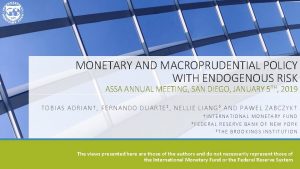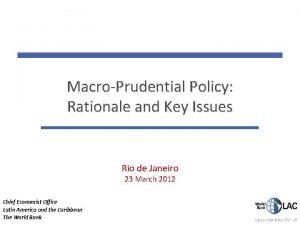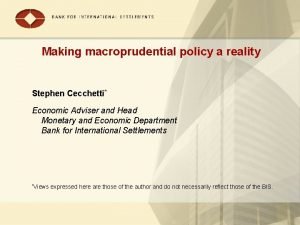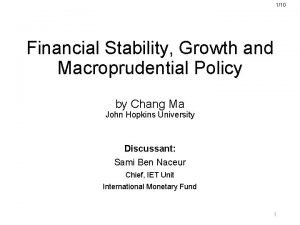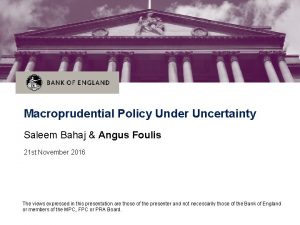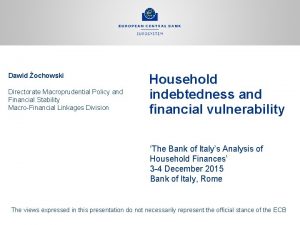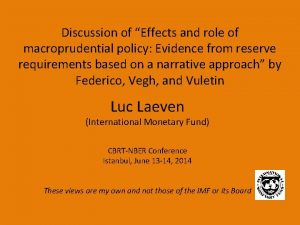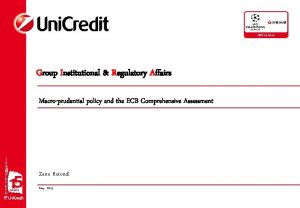What Is Macroprudential Policy Not It is Not













- Slides: 13

What Is Macroprudential Policy Not? It is Not a Silver Bullet! Presentation by William White Macroprudential Policy Conference IDA Conference Centre Copenhagen, Denmark 19 November 2018 1

What is the Fundamental Problem? • The crisis of 2008 had its roots in excessive credit creation • Lessons from economic history • Lessons from the history of economic thought • Neither price (monetary) nor financial stability are sufficient • Must address the root cause of credit, not symptoms • And the problems are getting worse 2

What Are Macroprudential Policies? • Macroprudential policies are not microprudential policies • The main difference is objectives not instruments • Microprudential is static and focussed on individual institutions • Macroprudential is dynamic and focussed on systemic stability • Instruments can be shared but a micro-macro tradeoff exists 3

Macroprudential Policies to Lean Against a Credit “boom” • The “lean vs clean” debate • How best to lean? • Monetary instruments not sufficient • Macroprudential instruments not sufficient • The need for coordinated resistance? • In principle, which instrument goes first? • In practice, no great appetite for either! 4

Macroprudential Polices to Support Financial Resilience • A much less ambitious response to a credit “boom” • The fall back position in UK, Europe and elsewhere? • A more credible objective, but still not a silver bullet 5

Macroprudential Policies in the “boom” : A Need to Act? • What are the key services provided by a stable financial system? • What is the level of tolerance for financial instability? • The crucial role of insolvency regimes • Need to identify growing systemic risks; indicators and data needs 6

Macroprudential Policies in the “boom”: What to Do? • What instruments are available? • Recognize that most available instruments have shortcomings • Rely on changing incentives or prohibition or both? • Assess the tradeoffs between instruments given multiple criteria • What do we know about “packages” of instruments? • Should policy changes be based on a rule or discretion? • Should policy changes be small or large? 7

Macroprudential Policies to Lean Against a Credit “bust” • In principle, ease macroprudential along with monetary easing • Arguments for and against a cyclically asymmetric response • In practice, macroprudential has tightened as monetary has eased • Macroprudential now supports “ultra-easy monetary policy” • It is not a silver bullet but is now part of the problem 8

But Ultra-Easy Monetary Policy Has Not Worked as Intended • Recovery of aggregate demand much less robust than expected • Inflation has generally come in below target • Many theoretical grounds for believing it might not work as intended • Just as Keynes himself suggested 9

And Ultra-Easy Monetary Policy Has Dangerous Side Effects • Side effects dangerous in spite of tighter macro prudential policies • Global debt ratio is 40 percentage points higher than 2007 • Corporate debt, especially in Emerging Markets, is a growing problem • Currency mismatch risks way up and many markets overpriced • Price discovery attenuated while Risk Off and Risk On amplified • Business models of financial institutions increasingly threatened • Threatening “potential” growth of the real economy in turn 10

Hoping for the Best While Preparing for the Worst • Something likely to go wrong somewhere • Trump administration policies raise the probability • A problem anywhere is a problem everywhere • Markets prone to over reaction • Limited appetite for a cooperative response • Limited room for a macro policy response • Need for anunprecedented scale of debt restructuring? • Or financial repression and (much) higher inflation? 11

More Radical Measures Needed to Avoid Future Debt Crises? • Coordinated resistance to “lean” against credit bubbles? • More symmetric use of monetary and fiscal policies? • Improve self discipline and market discipline in the financial sector? • End interest deductibility and limited liability banking? • Roll back globalisation, securitization and consolidation? • Consider “free banking” and “narrow banking”? • And get rid of safety nets and regulation? 12

Governance of Macroprudential Policies: Who Does What? • If the objective is “leaning”, then central banks should lead in upswing • But Treasuries should lead in downturns involving taxpayer money • If the objective is “financial resilience”, many agencies involved • In practice, no agreement on the best governance model • Most oversight agencies can only advise, not compel action • “Should” and “would” criteria favour central bank leadership • Even if this threatens “independence” 13
 Macroprudential policy
Macroprudential policy Macroprudential policies
Macroprudential policies Jisdor fixing
Jisdor fixing Not genuine not true not valid
Not genuine not true not valid Policy science should not be cloaked in the guise of
Policy science should not be cloaked in the guise of Love is not all imagery
Love is not all imagery Not a rustling leaf not a bird
Not a rustling leaf not a bird Being too broad
Being too broad Eyes that see and ears that hear
Eyes that see and ears that hear If you are not confused you're not paying attention
If you are not confused you're not paying attention You can not not communicate
You can not not communicate P
P Pp not not
Pp not not Casual vs informal
Casual vs informal
